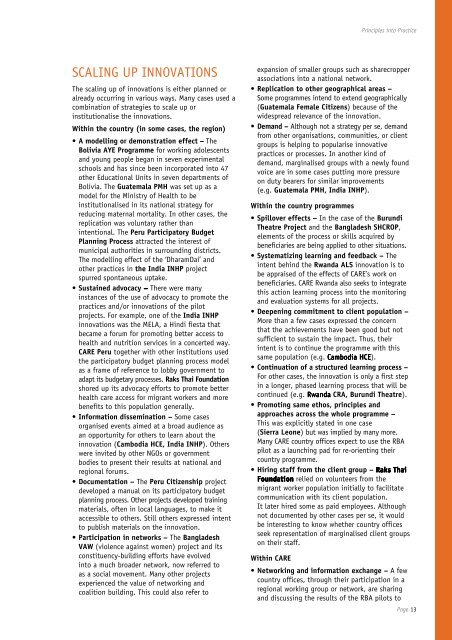Principles into Practice - Handicap International
Principles into Practice - Handicap International
Principles into Practice - Handicap International
- No tags were found...
You also want an ePaper? Increase the reach of your titles
YUMPU automatically turns print PDFs into web optimized ePapers that Google loves.
<strong>Principles</strong> <strong>into</strong> <strong>Practice</strong>SCALING UP INNOVATIONSThe scaling up of innovations is either planned oralready occurring in various ways. Many cases used acombination of strategies to scale up orinstitutionalise the innovations.Within the country (in some cases, the region)• A modelling or demonstration effect – TheBolivia AYE Programme for working adolescentsand young people began in seven experimentalschools and has since been incorporated <strong>into</strong> 47other Educational Units in seven departments ofBolivia. The Guatemala PMH was set up as amodel for the Ministry of Health to beinstitutionalised in its national strategy forreducing maternal mortality. In other cases, thereplication was voluntary rather thanintentional. The Peru Participatory BudgetPlanning Process attracted the interest ofmunicipal authorities in surrounding districts.The modelling effect of the ‘DharamDai’ andother practices in the India INHP projectspurred spontaneous uptake.• Sustained advocacy – There were manyinstances of the use of advocacy to promote thepractices and/or innovations of the pilotprojects. For example, one of the India INHPinnovations was the MELA, a Hindi fiesta thatbecame a forum for promoting better access tohealth and nutrition services in a concerted way.CARE Peru together with other institutions usedthe participatory budget planning process modelas a frame of reference to lobby government toadapt its budgetary processes. Raks Thai Foundationshored up its advocacy efforts to promote betterhealth care access for migrant workers and morebenefits to this population generally.• Information dissemination – Some casesorganised events aimed at a broad audience asan opportunity for others to learn about theinnovation (Cambodia HCE, India INHP). Otherswere invited by other NGOs or governmentbodies to present their results at national andregional forums.• Documentation – The Peru Citizenship projectdeveloped a manual on its participatory budgetplanning process. Other projects developed trainingmaterials, often in local languages, to make itaccessible to others. Still others expressed intentto publish materials on the innovation.• Participation in networks – The BangladeshVAW (violence against women) project and itsconstituency-building efforts have evolved<strong>into</strong> a much broader network, now referred toas a social movement. Many other projectsexperienced the value of networking andcoalition building. This could also refer toexpansion of smaller groups such as sharecropperassociations <strong>into</strong> a national network.• Replication to other geographical areas –Some programmes intend to extend geographically(Guatemala Female Citizens) because of thewidespread relevance of the innovation.• Demand – Although not a strategy per se, demandfrom other organisations, communities, or clientgroups is helping to popularise innovativepractices or processes. In another kind ofdemand, marginalised groups with a newly foundvoice are in some cases putting more pressureon duty bearers for similar improvements(e.g. Guatemala PMH, India INHP).Within the country programmes• Spillover effects – In the case of the BurundiTheatre Project and the Bangladesh SHCROP,elements of the process or skills acquired bybeneficiaries are being applied to other situations.• Systematizing learning and feedback – Theintent behind the Rwanda ALS innovation is tobe appraised of the effects of CARE’s work onbeneficiaries. CARE Rwanda also seeks to integratethis action learning process <strong>into</strong> the monitoringand evaluation systems for all projects.• Deepening commitment to client population –More than a few cases expressed the concernthat the achievements have been good but notsufficient to sustain the impact. Thus, theirintent is to continue the programme with thissame population (e.g. Cambodia HCE).• Continuation of a structured learning process –For other cases, the innovation is only a first stepin a longer, phased learning process that will becontinued (e.g. Rwanda CRA, Burundi Theatre).• Promoting same ethos, principles andapproaches across the whole programme –This was explicitly stated in one case(Sierra Leone) but was implied by many more.Many CARE country offices expect to use the RBApilot as a launching pad for re-orienting theircountry programme.• Hiring staff from the client group – Raks ThaiFoundation relied on volunteers from themigrant worker population initially to facilitatecommunication with its client population.It later hired some as paid employees. Althoughnot documented by other cases per se, it wouldbe interesting to know whether country officesseek representation of marginalised client groupson their staff.Within CARE• Networking and information exchange – A fewcountry offices, through their participation in aregional working group or network, are sharingand discussing the results of the RBA pilots toPage 13

















